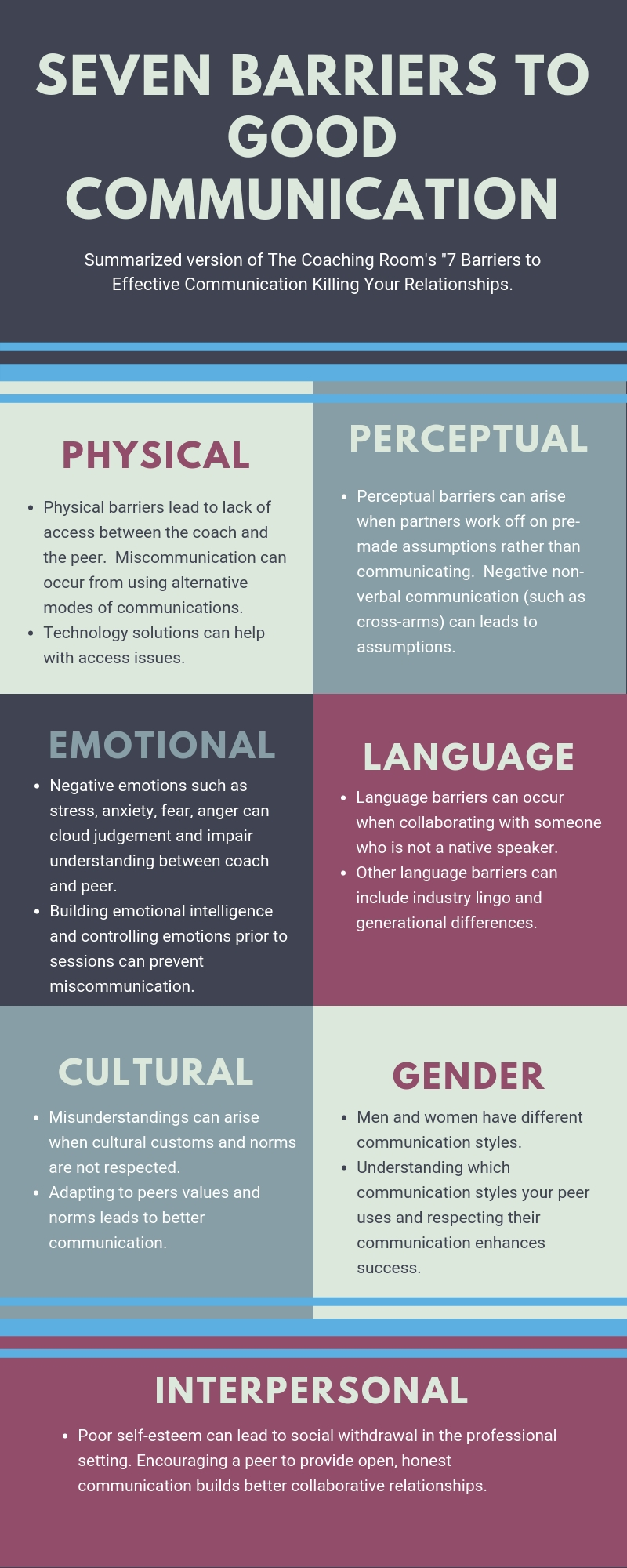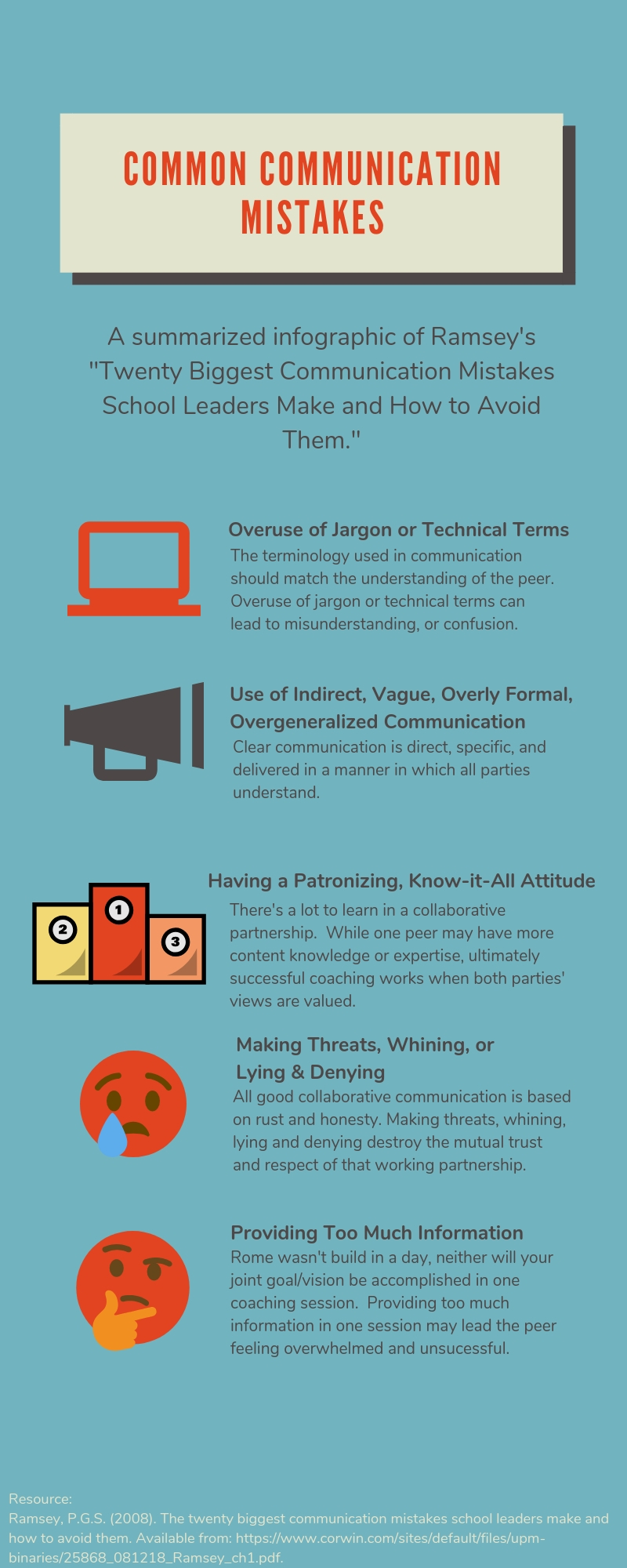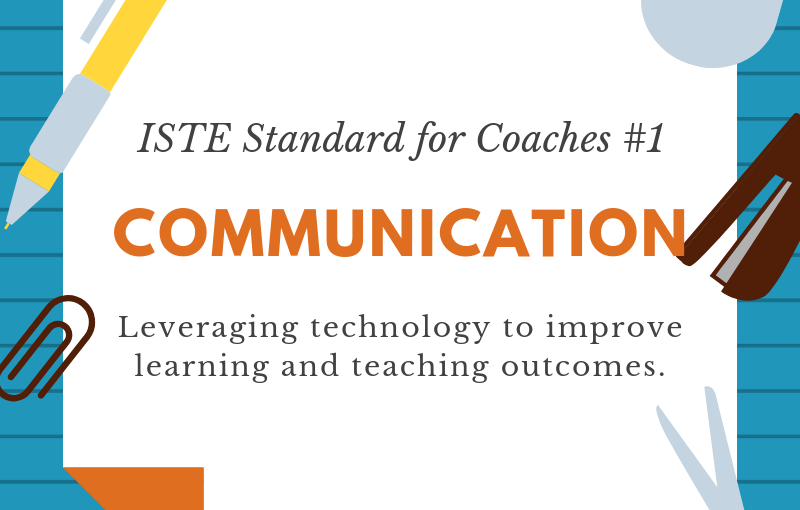If the foundation of effective peer coaching is collaboration, good communication is one of its pillars. Mark Ladin, CMO of Tiger Connect, an IT company, shares this mindset by defining communication and collaboration as one and the same. He argues that both communication and collaboration function on the exchange of information, however without good communication, you can’t have a functioning collaborative relationship that yields productive results, (Ladin, 2015). Therefore, eliminating miscommunication in partnerships promotes good collaboration, (Lohrey, n.d.). Collaborative communication offers many benefits including: creating flexible work environments that promote trust and familiarity, enhances decision-making by tackling problems through various angles, and increasing overall satisfaction of the collaboration process, (Lohrey, n.d.)
The ISTE Coaching Standard (1D) calls for coaches to implement strategies for initiating and sustaining technology innovations and manage the change process in schools and classrooms, (ISTE, 2017). A peer can feel comfortable enough to implement suggested strategies, when good communication between the collaboration peers is established. If good communication is central to collaboration, what miscommunication is common during peer coaching and what are some strategies to avoid it? This question does not readily yield concrete results on peer coaching alone, but rather there are several approaches to reasons for miscommunication including: modes of communication, a variety of communication barriers, and types of information given that may lead to miscommunication.
Modes of communication.
While mode of communication may not be the first thing to come to mind when considering miscommunication, the impact communication delivery has on conversation comprehension is compelling. According to Willy Steiner, an executive career coach, the degree of communication effectiveness compared to information efficiency differs when offered via face-to-face, telephone, or email communication, (Steiner, 2014). The author argues that face-to-face communication offers the best information efficiency (i.e. better understood) while email is most effective (i.e. quick). This can be further compounded by factoring in three types of communication: visual, verbal, and non-verbal. Face-to-face communication allows for better understanding in all three communication types, though it is the slowest communication mode. Email is the quickest mode but tends to promote higher levels of misunderstanding in verbal and visual communication and does not allow for any interpretation of non-verbal communication, (Steiner, 2014). A research study on adult learners using information communication technology found similar results. The aim of the study was to determine what type of information communication technology would better support virtual coaching. The results found that email was useful for the exchange of information but lacked the ability to create authentic communication experiences or relationships, and often led to more miscommunication, (Ladyshewky & Pettapiece, n.d.). Use of telephone technology was more effective than emailing because phone calls offered more verbal cues, while video-conferencing (mimicking face-to-face communication) was just as efficient as face-to-face conversations if technical issues are not present, (Ladyshewky & Pettapiece, n.d.). As a result, communication comprehension is a major consideration for avoiding miscommunication. When possible, face-to-face or similar communication modes should be used to help build relationships and deliver the most amount of understanding while limiting email to information transfer only.
Communication barriers.
Research shows that face-to-face communication better maximizes understanding and relationship building in collaborative partnership. However, even in face-to-face environments, several barriers may create inadvertent miscommunication events. According to the Coaching Room Company, there are seven potential barriers that may lead to ineffective coaching, summarized in figure 1.1 below.

Considering that many of these barriers involve understanding and respect of the coaching peer, developing a good collaborative relationship prior to working on the mutual project is essential for avoiding miscommunication.
Information miscommunication.
Peer coaching invites the coach to step into a leadership position in which the goal is to collaborate and facilitate work with a peer toward a mutual goal. Another area of potential miscommunication may stem from how the coach leader presents information to the peer. Figure 1.2 below lists the various information communication errors that may arise in leadership.

It is not only important to consider how communication is performed but also what is being communicated. Forbes Coaching Council expands on the communication errors provided in Figure 1.2 to focus on information clarity. Miscommunication can occur when the message is non-individualized or personal, (Forbes, 2018). Using the same strategies, communication techniques, and information to various coaching peers can harm the coaching relationship. A common miscommunication is use of vague, generic language or messages leading to lack of clarity in direction. The peer is left feeling like they are missing out on important information or that the information they were provided was not delivered effectively, (Forbes, 2018). To help eliminate the lack of direction, clear expectations that are developed by both parties can help promote the shared vision contributing to better collaboration. The peer leader should avoid communicating only negative outcomes, instead include the positive outcomes to avoid creating an image that the shared work is not successful, (Forbes, 2018). Lastly, it is crucial that the coach recognize their bias and remember that the process is not about their wants but the needs of the peer being coached. Business coach Tony Alessandra said it best, “You can choose to connect with others from their perspective, the way they want to be communicated with by modifying your own presentation style; or you can choose to meet only your own needs – facing the consequence misconnecting with others…,” (Alessandra, 2015).
Promoting good communication. Several of the communication barriers addressed above stem from how communication is delivered, what information is delivered, and how each party perceives that information. Good communication is established when both parties feel safe, comfortable, and trust one another in their collaborative environment. Both hold the responsibility of keeping an open-mind into the process and commit to relationship building. Only after good communication occurs between coaching peers can good collaboration exist.
Resources.
Alessandra, T. (2015). Expert advice- How you can prevent miscommunication. Available from: https://www.fripp.com/expert-advice-how-you-can-prevent-miscommunication/
Forbes Coaching Counsel. (2018). Common communication mistakes to avoid as board directors. Available from: https://www.forbes.com/sites/forbescoachescouncil/2018/01/18/common-communication-mistakes-to-avoid-as-a-board-of-directors/#6f86f4332b44
ISTE, (2017). ISTE standards for coaches. Available from: https://www.iste.org/standards/for-coaches
Ladin, M. (2015). Communication and collaboration: Why they are one in the same? Available from: https://www.tigerconnect.com/blog/communication-collaboration-theyre-one/
Ladyskewshy, R., Pettapiece, R.G. (n.d.). Exploring adult learners usage of information communication technology during a virtual peer coaching experience. Available from: https://espace.curtin.edu.au/bitstream/handle/20.500.11937/32326/227280_153211_Jnl_online_learning_full_paper.pdf?sequence=2&isAllowed=y
Lohrey, J. (n.d.) Importance of promoting collaborative communication in the healthcare environment. Available from: https://smallbusiness.chron.com/importance-promoting-collaborative-communications-health-care-environment-79568.html.
Ramsey, P.G.S. (2008). The twenty biggest communication mistakes school leaders make and how to avoid them. Available from: https://www.corwin.com/sites/default/files/upm-binaries/25868_081218_Ramsey_ch1.pdf.
Steiner, W. (2014). Avoiding communication breakdowns. Available from: https://executivecoachingconcepts.com/avoiding-communication-breakdowns/
The Coaching Room. (2016). 7 barriers to effective communication killing your relationships. Available from: https://www.thecoachingroom.com.au/blog/7-barriers-to-effective-communication-killing-your-relationships
